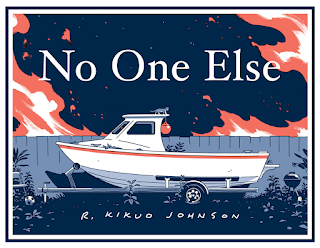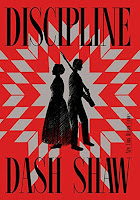Comics memoirs don't
have to be about something life-shattering that happened when you were younger. It just seems that way sometimes. And, to be honest, any book should be about something
important: one old piece of fiction-writing advice is that a story should be about the most important thing that ever happened to that person. [1]
Of course, not everyone has a father who survived the Holocaust, or fled their birth country when very young because of upheavals, or was unable to speak for months at a time, or had a major intestinal condition as a middle-schooler, or...so on. But everyone's life was changed, at least once. So everyone has at least that one story to tell.
Hazel Newlevant is a relatively young cartoonist, about a decade into their career. No Ivy League was their new graphic novel for 2019; my sense is this was a bigger book, maybe more of a breakout book, than Newlevant's previous work. I could easily be wrong: but the "Comics" page on Newlevant's site seems to mostly have shorter pieces. My sense is that cartoonists list all of their work until the list gets too long, and then prune down to book-length works and either just "Shorter Stories" or a couple of categories of those shorter pieces.
This is a story about a seventeen-year-old named Hazel. From the afterword, it's based on Newlevant's real life, with details changed for everyone else (like so many memoirs). Now, I want to apologize if I screw up pronouns from here on: Newlevant's site describes theirself as transmaculine and uses they/them pronouns, but the Hazel in the book presents as female and uses she/her. This is not a transition story: it's a story about a person who later transitioned, and I'm going to try to be precise in talking about Hazel (the seventeen-year-old character in the memoir) and Newlevant (the decade-older person who made the story).
Hazel is a high-achieving homeschooled kid in Portland, Oregon. She seems to be an only child, the kind whose parents poured everything they ever wanted into her upbringing, and that's the kind of homeschooling she had: the regular-schools-aren't-good-enough-for-my-awesome-child kind, not the keep-my-brood-away-from-secular-temptations kind. She has a small group of other homeschooled kids she hangs and works with regularly; they're making videos for a national contest to promote homeschooling with the hope of using that money to go on a road trip the coming fall to see the band Guster in concert.
Another making-money scheme is a summer job: Hazel gets hired into No Ivy League, a youth group that will spend the summer removing invasive ivy from Forest Park, a gigantic semi-wild area in the city. There she's thrown in with a large group of other kids her age for what may be the first time in a long time: certainly the most mixed group that she's ben part of, in race and background and outlook and life experience.
The bulk of the book is about Hazel's time with that group, for good and bad. She learns to play ultimate frisbee and gets sexually harassed; she works hard and has to deal with people very unlike those she's used to. There's no one lesson, no one big thing - she does get sexually harassed, but just once, briefly, and she reports it. The aftermath is messier, since it leads to her harasser being kicked out of the program, and everyone knows it was because of her.
(This is also mildly parallel to a very inappropriate flirting that Hazel carries on - one-sidedly, only from her - with one of the adult leaders. She says things to that leader arguably as bad as what was said to her, and does it over a longer period of time.)
The biggest piece of the experience is Hazel realizing how insulated homeschooling has made her, and how it's intertwined with her privilege. Like the grind she is, she tries to fix the situation by reading a bunch of books and learning better. (It's not the worst reaction, certainly! Frankly, it might be about the best possible one.)
No Ivy League is not about A Problem in the way so many memoirs are - or, if it is, the "problem" is vastly larger and ubiquitous. Hazel can't solve the problem, and it's not her problem the way it usually is in comics memoirs. She can learn more, and understand better, but all of her vegan living and good intentions won't change that most of No Ivy League is made up of "at-risk youth," and all of the ways that's coded, and all of the ways all of those kids have not been set up to succeed a tenth of the way she has.
Hazel does learn; she does do better. And one hopes the reader learns alongside her. I'm pretty sure that's why Newlevant chose this story to tell: it's a story about a young person learning more, and doing better. My sense is that No Ivy League is aimed at people like Hazel - young, well-meaning, probably more privileged than they realize, and in need of something to make them pop their heads up and look around.
Newlevant tells that story in a mostly quiet, naturalistic way. Their lettering is softly rounded, the art is watercolor but mostly in shades of greenish gray, the people are a little bit cartoony but their surroundings are precise and real. This is not a story that will hit you over the head; it will creep around the sides until you're right in the middle of it without realizing. Even if you're not a privileged seventeen-year-old, No Ivy League has a lot to offer.
[1] It's not perfect advice, obviously - what about series characters? But it's good new-creator advice, to focus on stories that really matter to your characters. And "your characters" are "you" for the autobio cartoonist.































